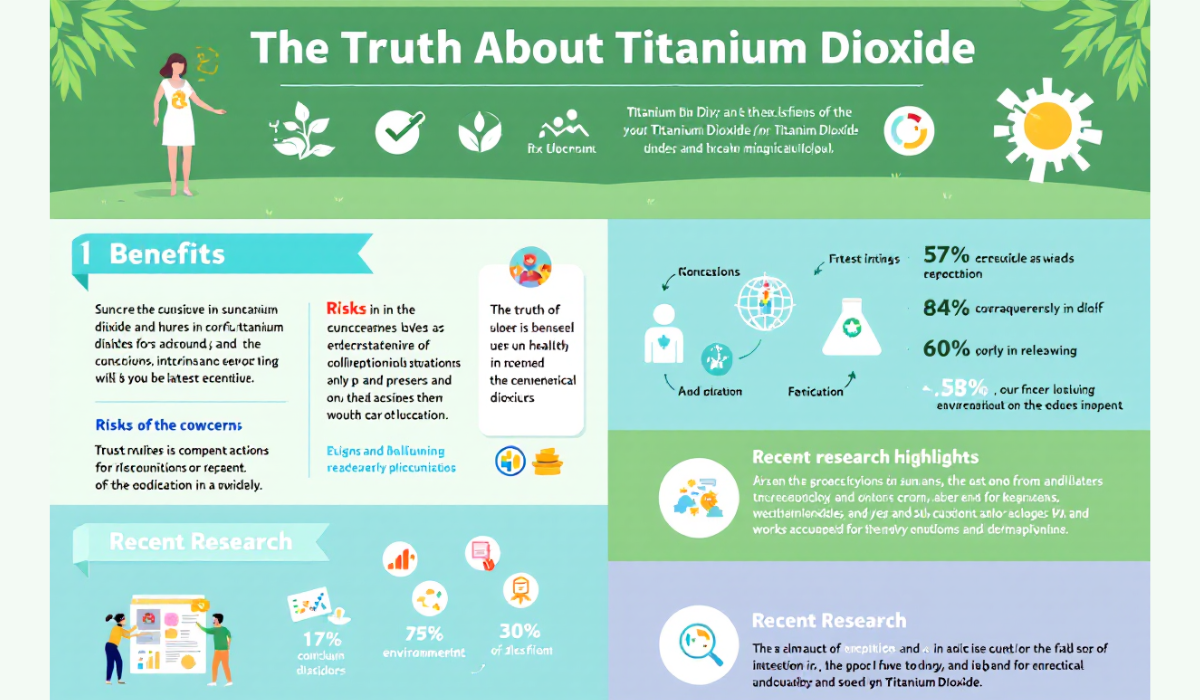The Truth About Titanium Dioxide: Benefits, Risks, and Latest Research Findings
What’s the real story behind titanium dioxide, the white powder found in everything from your morning donut to your favorite sunscreen? The truth about titanium dioxide (TiO2) is that it’s a widely used additive that serves as a whitening and brightening agent in thousands of everyday products. While it offers valuable benefits in various applications, recent research has raised important questions about its safety. In this evidence-based guide, we’ll explore the latest scientific findings on titanium dioxide, including: • Its proven benefits in UV protection and food preservation • Potential health risks, particularly from nanoparticle exposure • Current regulatory standings worldwide • Recent research findings from leading institutions Whether you’re a concerned consumer or simply seeking accurate information, this comprehensive analysis will help you understand the complex nature of TiO2 and make informed decisions about products containing this ubiquitous compound.
Key Takeaways:
- – TiO2 serves multiple purposes across industries, primarily as a whitening agent and UV protector in sunscreens, cosmetics, and food products.
- – Recent scientific studies have raised concerns about titanium dioxide nanoparticles, particularly regarding their potential inflammatory response and oxidative damage in the body.
- – The European Food Safety Authority has updated its stance on TiO2, leading to regulatory changes in the European Union regarding its use as a food additive.
- – Safety considerations vary based on exposure type (dermal, inhalation, or ingestion) and particle size, with nano-sized particles requiring special attention.
- – Current research indicates that while titanium dioxide is generally safe in conventional applications, certain manufacturing methods and product types may pose specific risks.
Applications in Food Industry
The food industry extensively utilizes titanium dioxide as a color additive to enhance the visual appeal of various products. This white pigment serves primarily as a whitening and brightening agent, making processed foods look more appealing to consumers.
Common Food Products Containing TiO2
The widespread use of titanium dioxide as an artificial color extends across numerous food categories. Here’s a comprehensive list of food products where you’re likely to encounter this additive:
– Candies and confectionery items
– Baked goods and pastries
– Dairy products (including coffee creamers)
– Processed snacks and chips
– Salad dressings and sauces
– Powdered drink mixes
– Chewing gum
– Ice cream and frozen desserts
Many brand-name food products incorporate titanium dioxide to achieve their characteristic white appearance. For instance, popular brands of ranch dressing, vanilla ice cream, and powdered donuts often contain this ingredient to maintain their pristine white color.
The concentration of titanium dioxide varies depending on the product type and desired effect. In some cases, it’s used in combination with other color additives to achieve specific shades or visual effects. Manufacturers typically list it on product labels as:
– Titanium dioxide
– E171
– CI 77891
– Food coloring (white)
Recent market research indicates that approximately 13,000 processed food items in the United States contain titanium dioxide. This prevalence highlights its significance in modern food manufacturing processes, although some companies are now exploring alternative whitening agents in response to growing consumer concerns.
💡 Key Takeaway: Titanium dioxide serves as a prevalent color additive in thousands of processed foods, primarily used for whitening and brightening, with applications ranging from confectionery to dairy products and baked goods.
Health and Safety Concerns
Research Findings on Health Risks
Recent scientific studies have raised significant concerns about the potential health impacts of titanium dioxide exposure. Research indicates that TiO2 particles, particularly in nano form, can trigger an inflammatory response in various body tissues.
Laboratory studies have demonstrated that when TiO2 particles enter cells, they can cause oxidative damage to cellular structures. This cellular stress may lead to various forms of cell damage, potentially affecting organ function over time.
Scientists have observed that titanium dioxide particles can accumulate in vital organs, including the liver, kidneys, and lungs. This accumulation raises concerns about long-term exposure effects, even at levels currently considered safe by regulatory standards.
One particularly concerning adverse effect is the potential impact on the digestive system. Studies have shown that TiO2 particles can disrupt the intestinal barrier and alter gut microbiota composition, potentially leading to inflammatory bowel conditions.
Research has also highlighted specific risks for vulnerable populations:
– Children may be more susceptible due to their developing organs and higher exposure relative to body weight
– Individuals with pre-existing respiratory conditions face increased risks from inhaled particles
– Workers in manufacturing facilities have higher exposure risks through occupational contact
The scientific community has documented several key findings:
– Chronic exposure may lead to systemic inflammation
– Nanoparticles can cross biological barriers more easily than larger particles
– Accumulation in tissues may trigger long-term health effects
– Interaction with cellular components can disrupt normal function
While acute toxicity appears low, researchers emphasize the need for more studies on chronic exposure effects. The cumulative impact of regular exposure through multiple sources remains a significant area of ongoing investigation.
💡 Key Takeaway: Scientific evidence suggests titanium dioxide can cause cellular damage and inflammatory responses, with particular concerns about long-term exposure effects and risks to vulnerable populations.
Exposure Routes and Safety Measures
Titanium dioxide exposure can occur through various routes, including skin contact, inhalation, and environmental sources. Understanding these exposure pathways is crucial for implementing effective safety measures, particularly in occupational settings where exposure risks are higher.
Occupational Safety Guidelines
Workers in industries handling titanium dioxide face significant workplace exposure risks. To minimize these risks, comprehensive safety protocols must be followed:
– Use appropriate Personal Protective Equipment (PPE):
– Respiratory protection devices
– Chemical-resistant gloves
– Protective eyewear
– Impervious clothing
– Implement engineering controls:
– Local exhaust ventilation systems
– Enclosed processing areas
– Dust collection systems
The primary concern in occupational settings is inhalation exposure, which can occur during manufacturing, packaging, or handling of titanium dioxide products. Regular air monitoring and proper ventilation systems are essential to maintain safe exposure levels.
Dermal exposure is another significant route that requires attention. While titanium dioxide has limited skin penetration, prolonged contact should be avoided through proper protective measures.
Environmental exposure can affect both workers and surrounding communities. Proper waste management and containment systems help prevent:
– Release of titanium dioxide particles into the air
– Contamination of water sources
– Soil pollution
– Ecosystem disruption
Regular workplace monitoring should include:
1. Air quality assessments
2. Surface contamination checks
3. Personal exposure monitoring
4. Equipment maintenance inspections
Training programs should educate workers about:
– Proper handling procedures
– Emergency response protocols
– Health hazard awareness
– Correct PPE usage
– Decontamination procedures
💡 Key Takeaway: Protecting against titanium dioxide exposure requires a multi-faceted approach combining proper PPE, engineering controls, and comprehensive training programs, with special attention to inhalation and dermal exposure risks in occupational settings.
Conclusion
As we’ve explored the multifaceted nature of titanium dioxide, it’s clear that this compound plays a significant role in our daily lives, from sunscreens to food products. While its benefits in UV protection and food preservation are well-documented, the emerging research on nanoparticle exposure and potential health risks cannot be ignored. Armed with this comprehensive understanding of titanium dioxide’s benefits, risks, and latest research findings, you can now make more informed decisions about the products you use. Whether it’s checking product labels, choosing titanium dioxide-free alternatives, or being mindful of occupational exposure, your awareness of both the advantages and potential concerns surrounding TiO2 is crucial for making health-conscious choices. Stay informed about ongoing research and regulatory changes regarding titanium dioxide, particularly from trusted sources like the European Food Safety Authority and the International Agency for Research on Cancer. Your health and safety should always be the priority when evaluating products containing this widely used compound.
FAQs
What is the difference between nano and non-nano titanium dioxide?
Nano titanium dioxide particles are less than 100 nanometers in size, while non-nano particles are larger. Nano particles have enhanced UV protection and transparency but raise more safety concerns due to their ability to penetrate cells. Non-nano particles are generally considered safer for topical use.
Can titanium dioxide accumulate in the body over time?
Recent studies suggest that titanium dioxide can accumulate in certain organs, particularly when consumed orally. The European Food Safety Authority has noted that while most particles are eliminated, some may build up in tissues over time, though the long-term implications need further research.
How can I identify products containing titanium dioxide?
Look for these names on ingredient labelstitanium dioxide, CI 77891, TiO2, or E171. In cosmetic products, it’s commonly listed among active ingredients. For food products, check the ingredient list, particularly in white-colored processed foods and confectionery items.
Are there natural alternatives to titanium dioxide?
Yes, several natural alternatives exist. For cosmetics, zinc oxide offers similar sun protection. For food, natural whitening agents include calcium carbonate, rice starch, and organic cornstarch. However, these alternatives may not provide identical functional properties.
Does titanium dioxide in sunscreen penetrate the skin?
According to current research and the Scientific Committee on Consumer Safety, properly formulated non-nano titanium dioxide in sunscreens stays on the skin’s surface and doesn’t penetrate into deeper layers, making it safe for dermal exposure.
How does heat affect titanium dioxide stability?
Titanium dioxide remains stable at high temperatures, which is why it’s widely used in manufacturing processes. Its high refractive index and photocatalytic activity remain constant even under heat, making it reliable for various industrial and consumer applications.





Post Comment